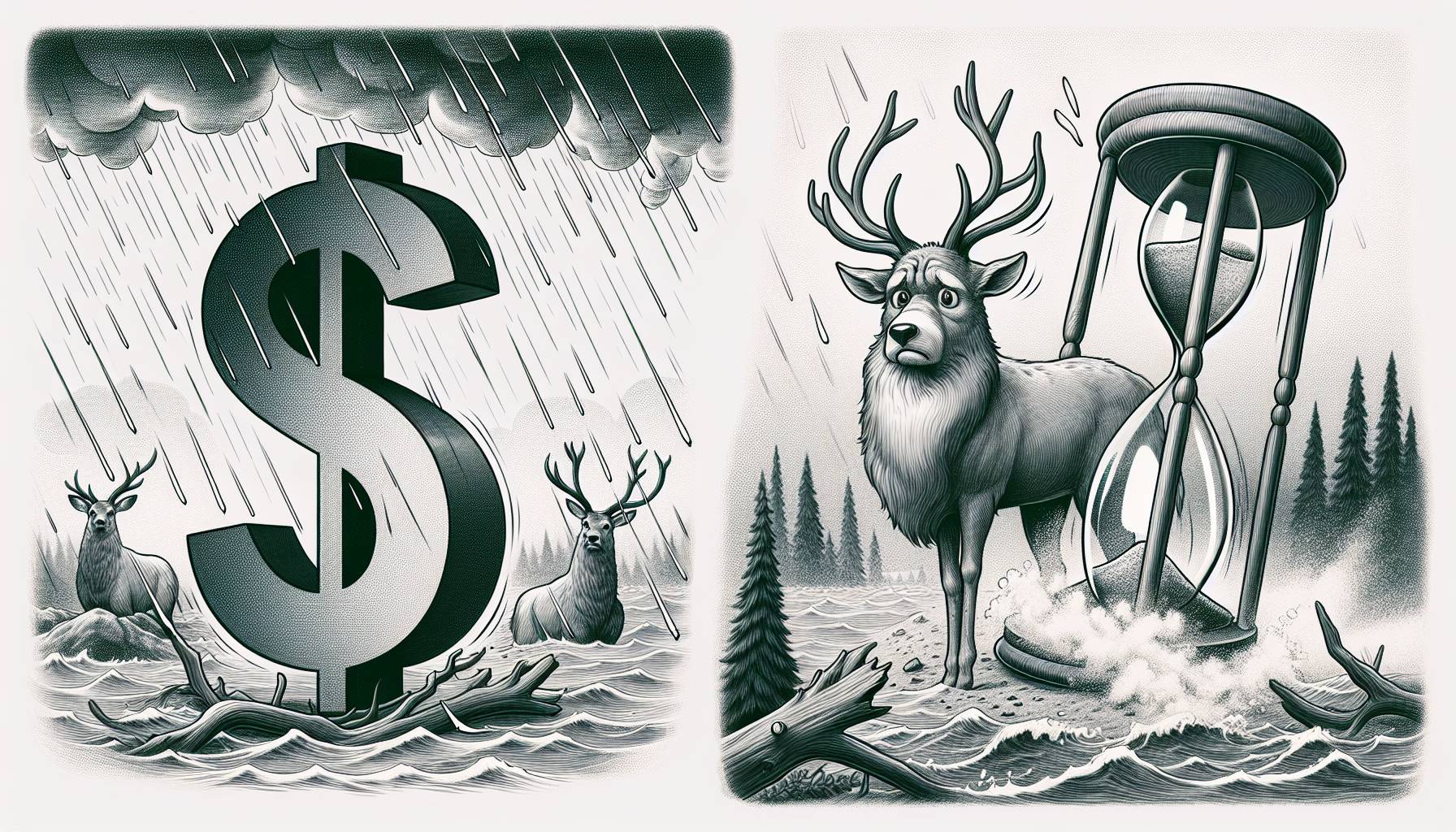Southern California recently experienced the effects of record breaking Tropical Storm Hurricane Hilary that hit the Region. While initial concerns were raised due to the storm’s earlier classification as a Category 4 hurricane, residents and officials were relieved to find that the impact was much less severe than anticipated. Despite heavy rain and localized flooding in some areas, there were no reports of deaths related to the storm as of Monday afternoon. This article delves into the details and aftermath of Hurricane Hilary, highlighting the preparedness measures taken and the positive effects of the drenching rains.
Avoiding Catastrophic Damage: An Overview of the Storm
As the storm moved into California, many desert and mountain communities were faced with the challenge of dealing with heavy rainfall and subsequent mudslides. Videos from San Bernardino and Riverside Counties showed creek beds filled with sludge-colored torrents carrying boulders and tree trunks. Neighborhoods in the desert cities east of Los Angeles also experienced flooding, with the mayor of Palm Springs even stating that the city was temporarily cut off due to road closures.
However, despite these challenges, Los Angeles and San Diego Counties, with a combined population of over 13 million, were fortunate to avoid any storm-related fatalities. Zev Yaroslavsky, a former Los Angeles county supervisor and city councilman, expressed his surprise, stating, “I can’t remember a major storm in which we had no fatalities.” This outcome was attributed to effective preparedness efforts and the ability to make their own luck.
Preparation and Response: A Test Passed
As news of the approaching storm spread, the Los Angeles Unified School District, the second-largest in the nation, took precautionary measures by canceling classes and after-school programs on Monday. Fortunately, these measures proved to be unnecessary, and classes resumed on Tuesday as planned.
In response to the storm, crews in various cities across Southern California and Nevada were deployed to address fallen trees, potholes, downed power lines, and localized road flooding. Despite these minor issues, officials expressed their relief that the impact on homes and residents was minimal. Brian Ferguson, a spokesman for the California Governor’s Office of Emergency Services, stated, “By and large, we’re feeling pretty good about it because we’re not seeing a lot of impacts to homes and residents. We’re not seeing a single fatality or injury as of yet.”
Digging Out of the Mud: Continuing Challenges From the Storm
While the immediate threat of Hurricane Hilary has passed, some parts of California continue to face challenges in the aftermath of the storm. The City of Palm Desert in the Coachella Valley urged residents to exercise caution as work crews continued to respond to reports of damage. City officials noted that many trees were downed and branches were broken, advising residents to avoid parks and flooded areas.
In Cathedral City, the chief of the Fire Department, Michael Contreras, reported that his staff had rescued 46 people in just 18 hours. This included the evacuation of 14 older residents from a board and care home, who were safely transported with the help of bulldozers. Similarly, in the San Bernardino Mountains, where some areas received over 10 inches of rain, roads turned into raging rivers filled with debris and mud. Residents in the Forest Falls community were advised to stay in their homes until the streets could be cleared.
State and local officials remain vigilant as they monitor fragile hillsides, which can still pose a threat even after the storm has passed. “We’re not out of the woods,” warned Brian Ferguson, highlighting the potential for mudslides up to 72 hours after the clouds have cleared.
Impact from Hilary on Surrounding Areas: Mexico and Nevada
Before reaching California, Hurricane Hilary brought significant rainfall to Mexico’s Baja California peninsula. Some areas recorded nearly 13 inches of rain in a 24-hour period, surpassing the previous record set in 1997. While flooding caused some damage and one person was killed by rushing floodwaters, Mexico’s president, Andrés Manuel López Obrador, expressed gratitude that the impact was not as severe as anticipated.
In Nevada’s Mt. Charleston area, west of Las Vegas, residents faced a different challenge as flooding caused a severe leak in the water system. As a precautionary measure, residents were advised to boil tap water before consumption.
Positive Effects: Relief from Fire Risks and Water Conservation
Interestingly, Hurricane Hilary had some unexpected positive effects in Southern California. At a time when the region is typically dry and prone to wildfires, the drenching rains helped dampen fire risks. Daniel Swain, a wildfire expert at the University of California, Los Angeles, explained that the prolonged reprieve in Southern California was a welcome relief.
Additionally, officials in Los Angeles County highlighted the success of projects aimed at diverting and storing rainwater. By Monday morning, the county had captured enough stormwater to supply at least 33,600 residents for a year. This achievement showcases the potential for water conservation efforts during heavy rainfall events.
Preparing for Future Challenges: Flood Insurance and Public Awareness
While the impact of Hurricane Hilary was less severe than expected, homeowners who suffered flood damage face the challenge of cleanup without the support of federal flood insurance. In a region unaccustomed to tropical downpours, less than 1 percent of households in Southern California have flood insurance. This highlights the importance of considering flood insurance policies to protect against future events.
Furthermore, the storm served as a reminder for residents in coastal areas to remain vigilant and prepared for potential storms. Despite some confusion in certain parts of California closer to the coast, where the storm did not match the anticipated severity, it is crucial for residents to stay informed and take necessary precautions during such weather events.
Conclusion: A Close Call and Lessons Learned
In conclusion, Southern California breathed a collective sigh of relief as Hurricane Hilary passed with no reported fatalities. Despite initial concerns about the storm’s potential impact, effective preparedness measures and a bit of luck resulted in minimal damage to homes and residents. The heavy rainfall provided unexpected benefits, such as reducing fire risks and promoting water conservation efforts. However, the challenges faced during this storm highlight the need for flood insurance and continued public awareness in coastal areas. As residents and officials continue to assess and address the aftermath of Hurricane Hilary, the region can be grateful for their preparedness efforts and the avoidance of catastrophic damage.
FAQs
Q: Was there any loss of life due to Hurricane Hilary in California? A: Fortunately, there were no reported deaths related to the storm as of Monday afternoon.
Q: How did Southern California prepare for the storm? A: The Los Angeles Unified School District canceled classes and after-school programs on Monday as a precautionary measure. Crews were also deployed to address fallen trees, potholes, and downed power lines.
Q: What were the challenges faced by residents in the aftermath of Hurricane Hilary? A: Some areas experienced localized flooding, mudslides, and damage to trees. Work crews were deployed to clear roads and respond to reports of damage.
Q: Were there any positive effects of the storm? A: The heavy rainfall helped dampen fire risks in Southern California and contributed to water conservation efforts.
Q: How can residents protect themselves from future flood damage? A: It is recommended that residents consider purchasing flood insurance policies, as most home insurance policies do not cover flooding.
Q: What lessons can be learned from Hurricane Hilary? A: The storm served as a reminder for residents to remain vigilant, prepared, and informed about potential weather events. It also highlighted the importance of flood insurance and water conservation efforts.
Q: How did Mexico and Nevada fare during the storm? A: Mexico’s Baja California peninsula experienced significant rainfall, but the impact was not as severe as anticipated. In Nevada, flooding caused a severe leak in the water system, leading to advisories to boil tap water before consumption.
First Reported on: NYT.com
Featured Image provided by: Roberto Nickson; Pexels – Thank you!













